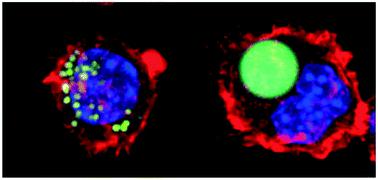当前位置:
X-MOL 学术
›
Environ. Sci.: Nano
›
论文详情
Our official English website, www.x-mol.net, welcomes your feedback! (Note: you will need to create a separate account there.)
Does size matter? A proteomics-informed comparison of the effects of polystyrene beads of different sizes on macrophages
Environmental Science: Nano ( IF 7.3 ) Pub Date : 2022-07-05 , DOI: 10.1039/d2en00214k Véronique Collin-Faure 1 , Bastien Dalzon 1 , Julie Devcic 1 , Hélène Diemer 2, 3 , Sarah Cianférani 2, 3 , Thierry Rabilloud 1
Environmental Science: Nano ( IF 7.3 ) Pub Date : 2022-07-05 , DOI: 10.1039/d2en00214k Véronique Collin-Faure 1 , Bastien Dalzon 1 , Julie Devcic 1 , Hélène Diemer 2, 3 , Sarah Cianférani 2, 3 , Thierry Rabilloud 1
Affiliation

|
Plastics are one of the most preoccupying emerging pollutants. Macroplastics released into the environment degrade into microplastics and nanoplastics. Because of their small size, these micro and nano plastic particles can enter the food chain and, in addition to their ecotoxicological effects, contaminate humans with still unknown biological effects. Plastics being particulate pollutants, they are handled in the human body by scavenger cells such as macrophages, which are important players in the immune system. In order to get a better appraisal of the effects of plastic particles on macrophages, we have studied the effects of unmodified polystyrene particles of 0.1, 1 and 10 micrometers of diameter, by a combination of proteomics and targeted validation experiments. Proteomics showed important adaptive changes of the proteome in response to exposure to plastics, with more than one third of the detected proteins showing a significance change in their abundance in response to cell exposure to at least one plastic bead size. These changes affected for example mitochondrial, lysosomal or cytoskeletal proteins. Although an increase in the mitochondrial transmembrane potential was detected in response to 10 micrometer beads, no alteration in cell viability was observed. Similarly, no lysosomal dysfunction and no alteration in the phagocytic capability of the cells was observed in response to exposure to plastics. When the inflammatory response was examined, no increase in the secretion of tumor necrosis factor or interleukin 6 was observed. Oppositely, the secretion of these cytokines in response to lipopolysaccharide was observed after exposure to plastics, which suggested a decreased ability of macrophages to respond to bacterial infection. In conclusion, these results provide a better understanding of the responses of macrophages to exposure to polystyrene particles of different sizes.
中文翻译:

大小重要吗?不同大小聚苯乙烯珠对巨噬细胞影响的蛋白质组学比较
塑料是最引人注目的新兴污染物之一。释放到环境中的大塑料会降解成微塑料和纳米塑料。由于它们体积小,这些微米和纳米塑料颗粒可以进入食物链,除了它们的生态毒理学效应外,还会以未知的生物效应污染人类。塑料是颗粒污染物,它们在人体内由巨噬细胞等清道夫细胞处理,巨噬细胞是免疫系统的重要参与者。为了更好地评估塑料颗粒对巨噬细胞的影响,我们结合蛋白质组学和靶向验证实验研究了直径为0.1、1和10微米的未改性聚苯乙烯颗粒的影响。蛋白质组学显示蛋白质组响应于塑料的重要适应性变化,超过三分之一的检测到的蛋白质显示出其丰度的显着变化,以响应细胞暴露于至少一种塑料珠大小。这些变化影响例如线粒体、溶酶体或细胞骨架蛋白。尽管响应于 10 微米的珠子检测到线粒体跨膜电位的增加,但没有观察到细胞活力的改变。同样,没有观察到溶酶体功能障碍,也没有观察到细胞在暴露于塑料时的吞噬能力发生变化。当检查炎症反应时,没有观察到肿瘤坏死因子或白细胞介素6的分泌增加。相反,在接触塑料后观察到这些细胞因子对脂多糖的反应,这表明巨噬细胞对细菌感染的反应能力下降。总之,这些结果提供了对巨噬细胞对暴露于不同尺寸聚苯乙烯颗粒的反应的更好理解。
更新日期:2022-07-05
中文翻译:

大小重要吗?不同大小聚苯乙烯珠对巨噬细胞影响的蛋白质组学比较
塑料是最引人注目的新兴污染物之一。释放到环境中的大塑料会降解成微塑料和纳米塑料。由于它们体积小,这些微米和纳米塑料颗粒可以进入食物链,除了它们的生态毒理学效应外,还会以未知的生物效应污染人类。塑料是颗粒污染物,它们在人体内由巨噬细胞等清道夫细胞处理,巨噬细胞是免疫系统的重要参与者。为了更好地评估塑料颗粒对巨噬细胞的影响,我们结合蛋白质组学和靶向验证实验研究了直径为0.1、1和10微米的未改性聚苯乙烯颗粒的影响。蛋白质组学显示蛋白质组响应于塑料的重要适应性变化,超过三分之一的检测到的蛋白质显示出其丰度的显着变化,以响应细胞暴露于至少一种塑料珠大小。这些变化影响例如线粒体、溶酶体或细胞骨架蛋白。尽管响应于 10 微米的珠子检测到线粒体跨膜电位的增加,但没有观察到细胞活力的改变。同样,没有观察到溶酶体功能障碍,也没有观察到细胞在暴露于塑料时的吞噬能力发生变化。当检查炎症反应时,没有观察到肿瘤坏死因子或白细胞介素6的分泌增加。相反,在接触塑料后观察到这些细胞因子对脂多糖的反应,这表明巨噬细胞对细菌感染的反应能力下降。总之,这些结果提供了对巨噬细胞对暴露于不同尺寸聚苯乙烯颗粒的反应的更好理解。



























 京公网安备 11010802027423号
京公网安备 11010802027423号